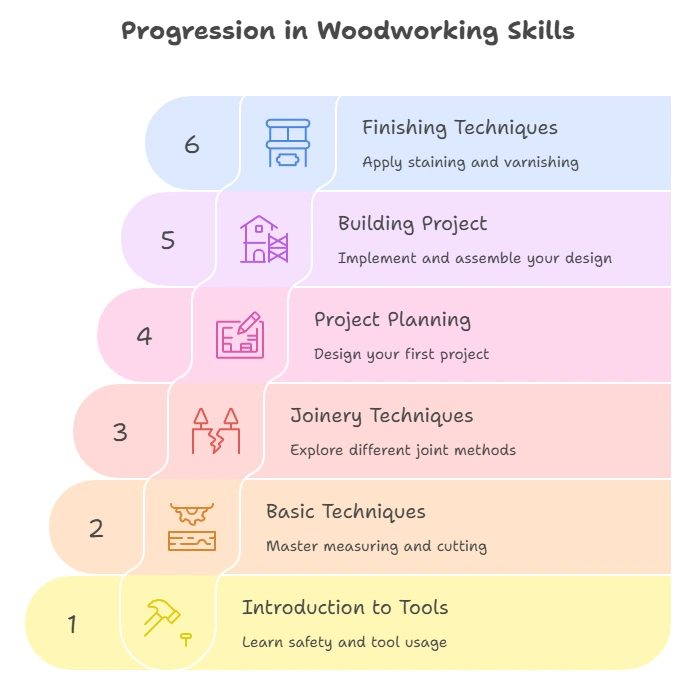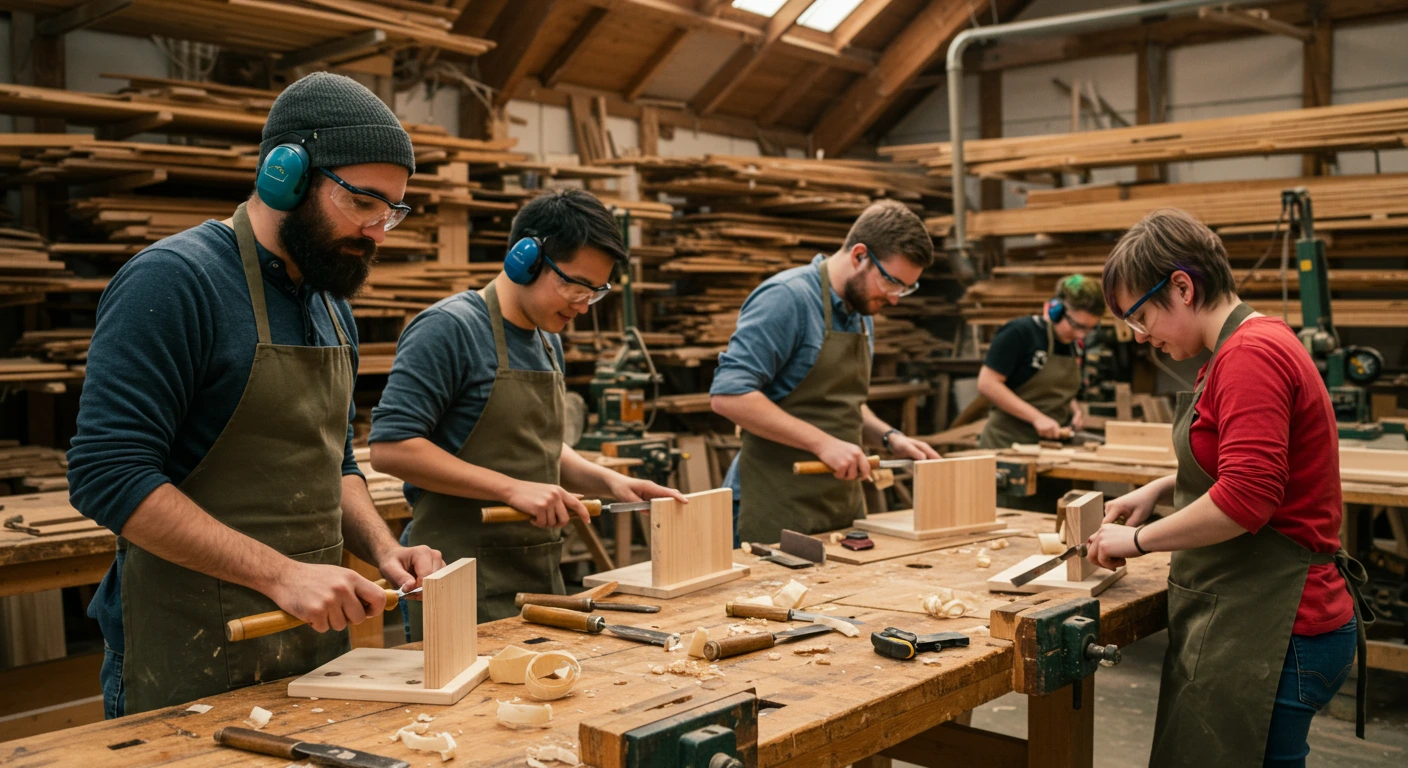
Getting started in woodworking can seem daunting, especially if you’re new to tools and techniques. However, enrolling in woodworking classes can open a world of creativity and hands-on learning. Here are some compelling reasons why those just beginning their woodworking journey should consider taking classes.
Skill Development
Woodworking classes provide a structured learning environment, especially beneficial for beginners. Here’s what you’ll gain:
- Fundamental Skills: Learn essential woodworking techniques, from measuring and cutting to assembling and finishing.
- Tool Handling: Understand how to use various tools safely and effectively.
- Problem Solving: Develop the ability to troubleshoot common woodworking issues that arise during a project.
Access to Expert Guidance
One of the greatest benefits of taking woodworking classes is access to experienced instructors. Instructors offer personalized insights that you might not be able to find on your own. They will share tips and tricks that can save you time and frustration. You’ll also receive immediate feedback, helping you improve quickly.
A Community Experience
Joining a woodworking class allows you to meet like-minded individuals who share your passion. This camaraderie can lead to lasting friendships and collaboration. Being part of a community provides encouragement and motivation, which can be especially helpful when facing challenges in your woodworking projects.
Structured Curriculum
Many woodworking classes are carefully designed to help you progress from basic to more advanced projects. Here’s what a typical curriculum might include:
| Week | Focus | Skills Learned |
|---|---|---|
| 1 | Introduction to Tools | Safety, Tool Usage |
| 2 | Basic Woodworking Techniques | Measuring, Cutting |
| 3 | Joinery Techniques | Different Joint Methods |
| 4 | Project Planning | Designing Your First Project |
| 5 | Building Your Project | Implementation, Assembly |
| 6 | Finishing Techniques | Staining, Varnishing |
Hands-On Learning
Woodworking requires practice, and classes provide you with the opportunity to work on actual projects. Instructors guide you through each step, ensuring that you’re making progress while focusing on proper techniques. This hands-on experience is invaluable and is often the best way to solidify your skills.
Access to Tools and Materials
Many local woodworking classes offer access to a variety of tools and materials you might not have at home. This provides a low-cost way to experiment with different equipment without the commitment of purchasing everything. Using high-quality tools can also enhance your learning experience, enabling better results.
Building Confidence
As you learn and practice your skills, you’ll find that your confidence grows. Completing a project can give you a sense of accomplishment that motivates you to take on even bigger challenges. This newfound confidence often translates into other areas of your life as well.
Resources for Finding Classes
If you’re eager to jump into woodworking classes, several resources can point you in the right direction:
- Woodcraft – Offers a variety of classes at different skill levels across the country.
- Woodworking Talk – A community forum where you can find classes and connect with experts.
- Udemy – Online courses you can take at your own pace, covering everything from basic to advanced woodworking skills.
By making the decision to enroll in woodworking classes, you’re taking a significant step towards cultivating a rewarding hobby that can lead to lifelong skills. Whether you want to craft furniture, create decorations, or repair items around your home, the knowledge and experience gained through these classes will serve you well on your woodworking journey.
Essential Tools Every Woodworking Class Should Teach
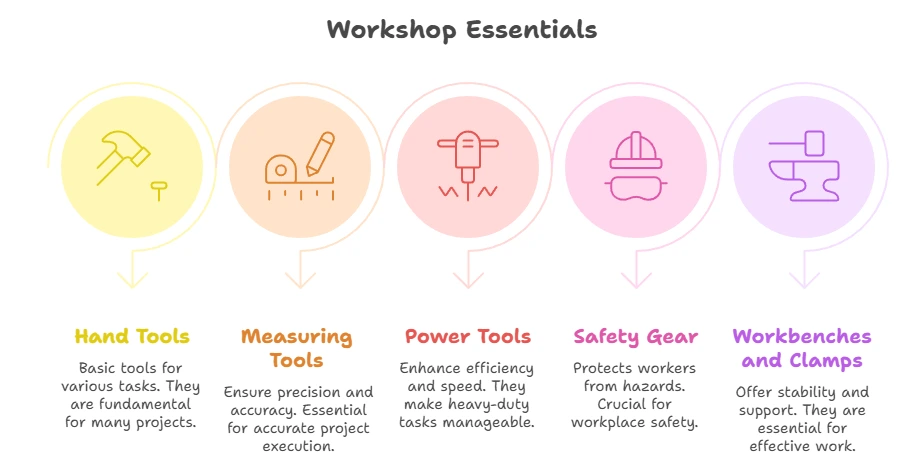
Woodworking classes are a fantastic way to explore your creativity and hone your skills in crafting beautiful projects. To thrive in these classes, it’s essential to become familiar with the right tools. These tools not only enhance your woodworking experience but also ensure safety and precision. Let’s explore the essential tools every woodworking class should teach you.
Hand Tools
Hand tools are the backbone of woodworking. They offer control and finesse that power tools sometimes cannot match. Here are some key hand tools you’ll encounter in woodworking classes:
- Saws: A handsaw, coping saw, or dovetail saw helps you make accurate cuts. Learning how to handle these saws is vital for shaping your projects.
- Chisels: Wood chisels come in various sizes and shapes. They are perfect for carving and adding details to your woodworking projects.
- Planes: A hand plane smooths rough edges and surfaces, providing a polished finish to your workpiece.
- Files and Rasps: These tools are essential for refining the surface and shape of wood. They remove material with precision and help create intricate designs.
Measuring Tools
Accurate measurements are crucial in woodworking. You’ll learn to use various measuring tools, including:
- Measuring Tape: A flexible measuring tape is important for measuring long distances and ensuring your cuts are precise.
- Combination Square: This tool helps you check right angles, measure lengths, and mark straight lines.
- Caliper: Accurate calipers are handy for measuring the thickness of wood and ensuring your pieces fit together perfectly.
Power Tools
While hand tools are essential, woodworking classes also introduce power tools that can speed up the process and increase efficiency. Here are some must-have power tools:
- Router: A router is versatile, allowing you to shape edges and create decorative features on your pieces.
- Drill: An electric drill is necessary for making pilot holes, driving screws, and creating varied holes for hardware.
- Sander: Sanders help achieve smooth surfaces quickly. You’ll often work with orbital sanders or belt sanders in classes.
- Table Saw: A table saw is pivotal for making precise crosscuts and rip cuts. Understanding how to use it safely is a primary focus in advanced woodworking classes.
Safety Gear
Safety should always come first in any woodworking class. Learning about and using the right safety gear is vital. Essential items include:
- Safety Glasses: Protect your eyes from dust, debris, and flying particles.
- Ear Protection: Power tools can be loud, so having earplugs or headphones will protect your hearing.
- Dust Mask: Wood dust can be harmful when inhaled, so using a dust mask is crucial.
- Work Gloves: Good quality gloves protect your hands during handling and assembly.
Workbenches and Clamps
Your workspace greatly affects your productivity and ease of work. A sturdy workbench is essential for laying out your materials and executing your projects. Adding clamps to your toolkit will help you hold pieces together securely while you work, ensuring accurate cuts and joints.
Woodworking Classes: Finding the Right Fit
When searching for the perfect woodworking class, you want to find one that offers hands-on training with all the essential tools mentioned above. Look for local community colleges, studios, or workshops that provide structured sessions for beginners and advanced woodworkers alike. Resources like Woodworkers Source can guide you in choosing the right courses.
The right tools into your woodworking education can dramatically enhance your skills and projects. Every class teaches you how to handle, maintain, and care for each tool, crucial for a successful woodworking journey. Stay curious, practice consistently, and most importantly, have fun while creating!
Exploring Different Types of Woodworking Classes Available
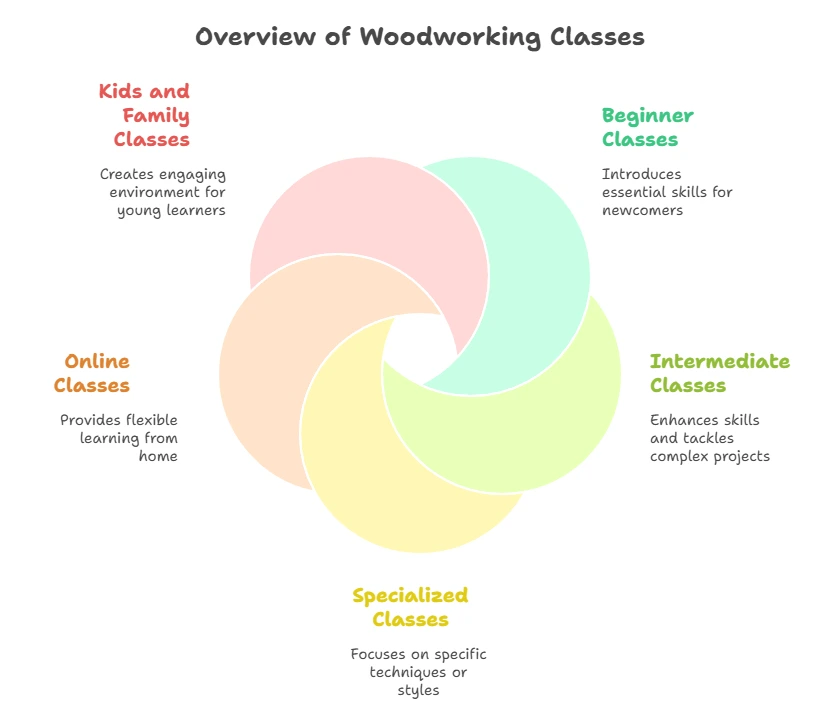
If you’re looking to dive into the world of woodworking, you’ll find that there are many types of woodworking classes available. Whether you are a beginner hoping to learn the basics or an advanced woodworker seeking to refine your skills, there’s a class perfect for you. Below, we explore different options and styles of woodworking classes to help you choose the one that suits your needs the best.
Beginner Woodworking Classes
For those just starting out, beginner woodworking classes are a fantastic way to build a foundation. These classes typically cover the following:
- Safety Procedures: Understanding how to use tools safely is essential.
- Basic Skills: Learning fundamental skills such as measuring, cutting, sanding, and joining wood.
- Project Completion: Most classes will guide you through completing a simple project, like a small shelf or a birdhouse.
Many local community centers and craft shops offer these classes. Websites like Woodworking Tool Tips can direct you to nearby classes.
Intermediate Woodworking Classes
If you already have basic skills, intermediate woodworking classes can help you level up your craft. These classes usually include:
- Joinery Techniques: Learn different ways to join wood more effectively.
- Wood Selection: Discover how to choose the right type of wood for different projects.
- Advanced Tools: Work with tools like routers, planers, and more complex machines.
Many technical schools and woodworking associations offer intermediate workshops. Consider checking Woodworker’s Source for options in your area.
Specialized Woodworking Classes
Once you have mastered the basics and intermediate skills, you might want to explore specialized classes. These classes focus on unique techniques or types of projects, such as:
- Furniture Making: Design and build custom furniture pieces.
- Cabinet Making: Focus on the intricacies of crafting cabinets and storage solutions.
- Restoration Workshops: Learn how to restore and refurbish old wooden items.
Specialized classes can often be found at local craft studios or through vocational schools. Exploring options on platforms like Woodworking Network might be worthwhile.
Online Woodworking Classes
The rise of digital learning has opened up a world of possibilities in woodworking education. Many platforms now offer online woodworking classes, which can provide flexible learning opportunities. Here are some benefits:
- Flexible Schedule: Learn at your own pace, whenever you have time.
- Variety of Options: Access a wide range of classes from various experts.
- Community Support: Join online forums and groups for peer feedback and encouragement.
Popular platforms such as Udemy and Craftsy offer numerous woodworking classes that you can explore from the comfort of your home.
Kids and Family Woodworking Classes
If you’re looking for family-friendly activities or classes for kids, many woodworking centers offer classes designed for younger individuals. These classes typically focus on:
- Fun Projects: Kids can craft toys, simple furniture, or decorative items.
- Teamwork and Skills: Classes often encourage family participation, teaching teamwork and problem-solving skills.
- Safety and Responsibility: Apprentices learn the importance of safety in a supportive environment.
Check local community centers or organizations like Woodcraft for kid-friendly classes.
Exploring woodworking classes can be an exciting journey. Whether you want to rekindle an old hobby or learn new skills, there are plenty of options tailored just for you. Invest time in finding the right class, and you will not only learn but also indulge in a rewarding craft!
How Woodworking Classes Foster Creativity and Problem-Solving
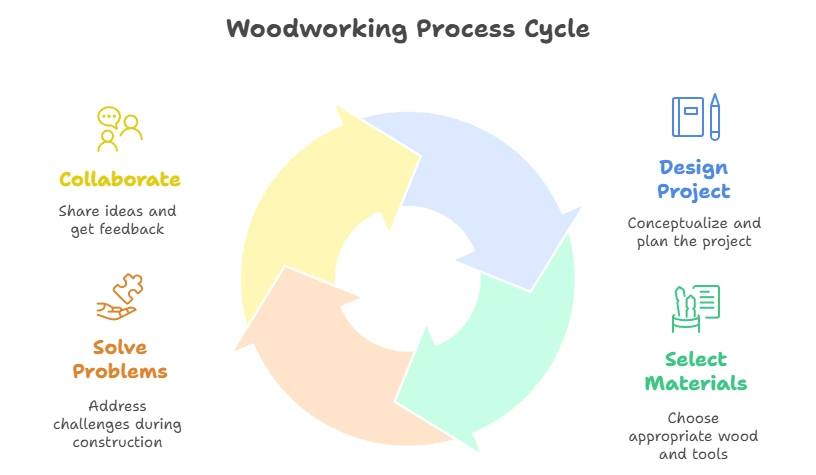
Engaging in woodworking classes can be a fantastic way to unlock your creativity and enhance your problem-solving skills. These classes provide not only hands-on experience but also an opportunity to think critically and approach challenges with a fresh perspective.
When you step into a woodworking class, you’re greeted by the scent of freshly cut wood and the hum of machines at work. This environment alone can spark inspiration. As you learn to create various projects—ranging from simple wooden toys to intricate furniture—you’ll discover that every task comes with its own set of creative hurdles. This drives you to think outside the box, exploring different techniques and materials to achieve your desired outcome.
One of the key benefits of woodworking is the emphasis on planning and execution. Here’s how this process fosters creativity and problem-solving skills:
- Designing Your Project: Before you even pick up a tool, you’ll need to conceptualize what you want to make. This requires you to think creatively about your design. Will you sketch it out on paper or use a software tool? Each decision influences the project direction.
- Material Selection: Choosing the right wood and tools can greatly affect your project’s success. As you explore different types of wood, you’ll learn how each one’s grain, hardness, and flexibility can impact the final product.
- Problem Solving: During the construction phase, errors can arise. Perhaps a cut is too short, or you run into unexpected challenges. This is where problem-solving comes into play. You may need to rethink your approach, adapt your plans, or use alternative methods to salvage your project.
- Collaboration and Feedback: Working alongside fellow class members allows you to share ideas and get feedback on your work. This collaborative environment not only helps you refine your skills but also encourages you to view problems from different angles.
Craftsmanship in woodworking isn’t just about making something functional; it’s an art. The moment you shape and refine your project, you cultivate a sense of satisfaction and ownership. Each cut and joint becomes a testament to your problem-solving journey, making the final product much more meaningful.
Moreover, woodworking helps build practical skills that translate into everyday problem-solving. For instance, developing precision and focus in your work teaches you patience. Learning how to measure and cut accurately reinforces critical thinking as you assess what adjustments must be made. Over time, these skills can boost your confidence in handling various challenges beyond the workshop.
Additionally, the psychological benefits of engaging in hands-on work shouldn’t be overlooked. The physical act of creating can be therapeutic, offering stress relief and a sense of accomplishment. Here are some mental benefits you can gain from woodworking classes:
- Mindfulness: Concentrating on a single project can improve your focus and presence in the moment.
- Persistence: Overcoming challenges in your builds teaches resilience, showing you that mistakes are opportunities to learn.
- Creativity Boost: The act of creating engages different parts of your brain, sparking ideas that can enhance your creative thinking in other areas of life.
If you’re eager to explore your creative potential and improve your problem-solving skills, consider enrolling in a woodworking class. Whether you’re a novice or an experienced craftsman, every class offers new opportunities to learn and grow.
Many community colleges and local shops offer woodworking classes that cater to varying skill levels. Resources such as Woodworkers Source or Popular Woodworking can help you find classes near you.
These platforms provide valuable information on available courses and workshops.
Not only do woodworking classes sharpen your creative edge and enhance your problem-solving skills, but they also connect you to a community of like-minded individuals. So grab your tools, and start your woodworking journey, where every project is a chance to learn something new.
Tips to Choose the Right Woodworking Class for Your Skill Level

When you’re eager to learn woodworking, picking the right class can make all the difference in your experience. Whether you’re a beginner or more experienced, the right class will help you hone your skills, inspire creativity, and build confidence. Here are some essential tips to help you choose woodworking classes that fit your skill level.
Assess Your Current Skills
Before selecting a woodworking class, take time to evaluate your current skills. Ask yourself the following questions:
- Have you ever worked with wood before?
- Do you know how to use basic tools like a saw, drill, or chisel?
- Are you familiar with different types of wood and their properties?
Your answers will guide you in choosing a class that’s right for you. A beginner should start with foundational skills, while more advanced woodworkers can look for specialized classes focusing on techniques or projects.
Research Available Classes
Different organizations and institutions offer woodworking classes, including local community colleges, craft schools, and woodworking clubs. Each class may focus on various aspects, such as furniture making, cabinetry, or carving. Here are some places to explore:
Each of these resources provides information on available classes, their content, and instructors, which can help in making an informed decision.
Consider Class Size and Format
The size and format of the class can greatly influence your learning experience. Smaller classes often allow for more personalized attention from instructors, while larger classes might offer a wider variety of skills being demonstrated. Consider these factors:
- Class Size: Smaller groups (5-10 students) provide individual feedback, while larger groups may be more lecture-focused.
- Online vs. In-Person: Online classes offer flexibility, whereas in-person classes provide hands-on experience with tools.
Decide what environment works best for your learning style and personal comfort.
Check the Instructor’s Qualifications
The expertise of the instructor can significantly affect your learning experience. Look for these qualifications:
- Experience in woodworking and teaching
- Specializations that align with your interests
- Positive reviews or testimonials from former students
Educators who have a passion for woodworking often bring more energy and enthusiasm to their teaching, making the class enjoyable and engaging.
Evaluate Curriculum Content
Each woodworking class comes with its curriculum. Make sure the class covers topics appropriate for your skill level. For beginners, look for classes that teach fundamental techniques, shop safety, and tool usage. More advanced classes might delve into specific projects or techniques, such as:
- Joinery techniques
- Wood finishing
- Advanced project work
Review the class syllabus or outline before enrolling to ensure it aligns with your learning goals.
Look for Hands-On Opportunities
Woodworking is a hands-on skill, so make sure the class emphasizes practical experience. Classes that include project work allow you to apply what you’ve learned in real-time, enhancing your understanding and retention. Ask about:
- Projects included in the class
- Access to tools and materials
- Support during project completion
Being able to create a finished product boosts confidence and satisfaction in your learning journey.
Read Reviews and Testimonials
Before committing to any woodworking class, read reviews from former students. Websites and social media platforms often feature feedback that can give you insights into the class quality and instructor effectiveness. Look for specifics about:
- Student satisfaction
- Instructor engagement
- Real-world application of skills learned
The experiences of others can offer valuable insight into whether the class is a good fit for your needs.
Choosing the right woodworking class can propel your skills to new heights. By assessing your current knowledge, researching class options, and considering factors like class size and content, you’ll be well on your way to creating amazing wood projects. Happy woodworking!
